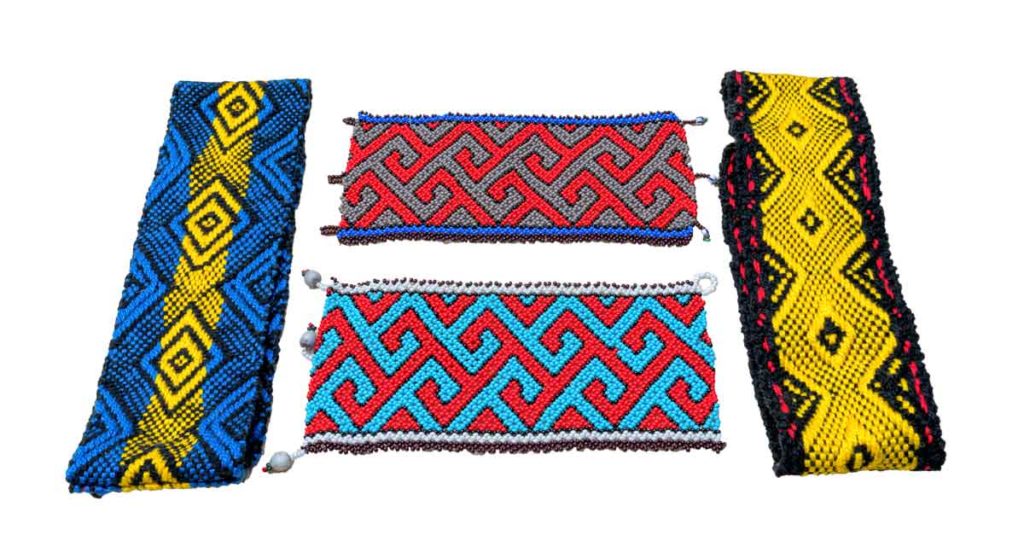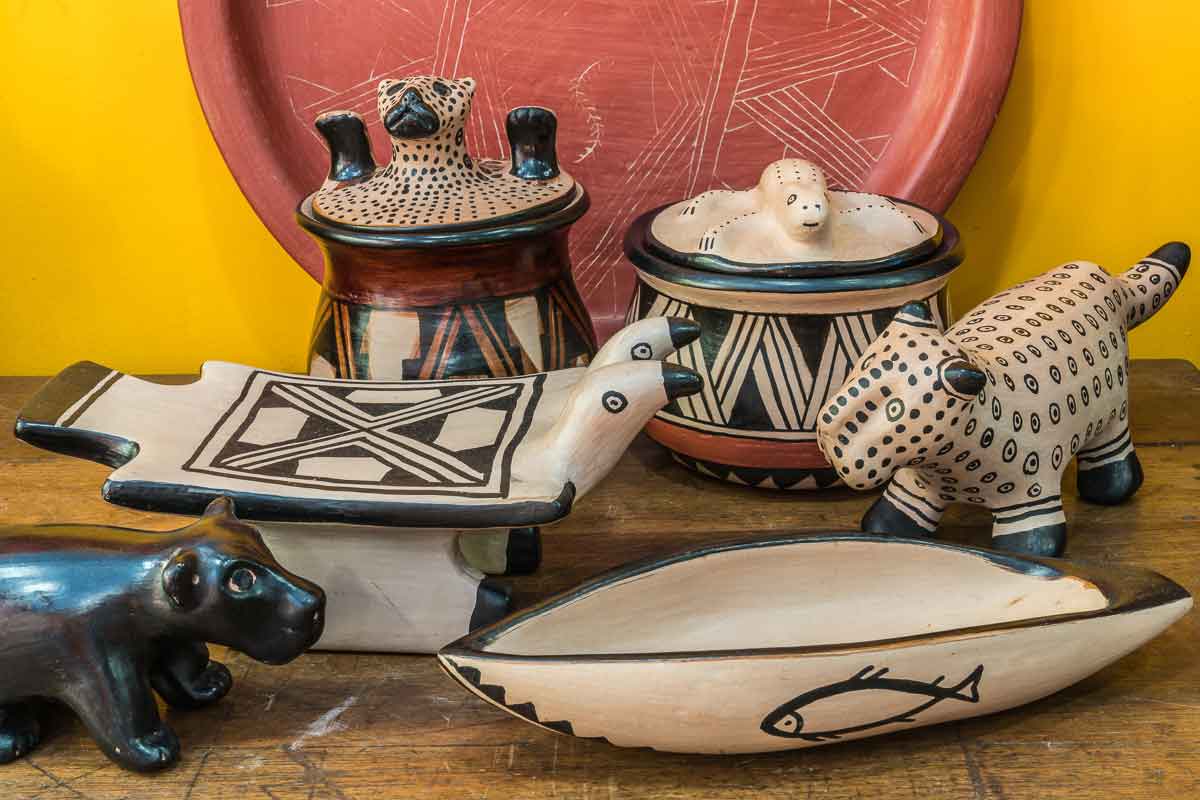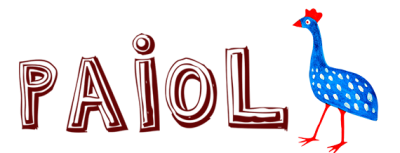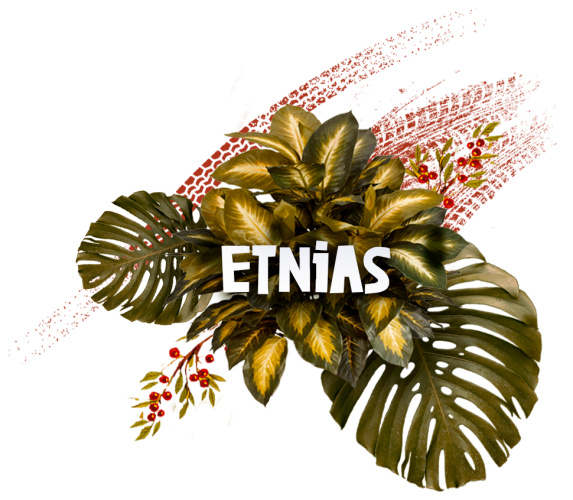
Tariana
Brazil's border with Colombia
It is believed It is believed that the Tariana ethnic group is a descendant of the Aruak tribes, who arrived in South America almost seven centuries ago, coming from the Caribbean.
Integrated today into the Tukana society – like these, the Tariano are one of the Brazilian tribes most open to marriages with other ethnicities – its population is spread in settlements along the tributaries of upper and middle Rio Negro, in the northwest of the state of Amazonas, and also on the border between Brazil and Colombia. Their craftsmanship is strongly linked to working with straw, material with which they produce delicate baskets and colorful jewel cases.

Terena
Mato Grosso do Sul - Brazil
The last remmants of the Guaná Nation, the history of the Terena tribe in Mato Grosso do Sul over the last two centuries is similar to that several other tribes in the region, full of conflicts with private farms, frequent location changes and adaptation to the presence of the man. Today, the Terena that resist in the state live in small “islands” near cities like Aquidauana and Miranda, close to Pantanal. They work in agriculture, supplying various products to food street markets near their villages, while trying to preserve their traditional cultural manifetations.
Ammong these manifestations, handicrafts with clay play an important social role. First, the work is started by the men of the village, responsible for collecting the material and, later, for the burning process. Then the clay is passed on to the women, who apply their creativity to the formation of traditional pieces such as stylized animals, vases, pans, pots and other utensils painted all with a red pigment and minimalist graphics which give the pottery a very characteristic vibrant aspect of this crafts.
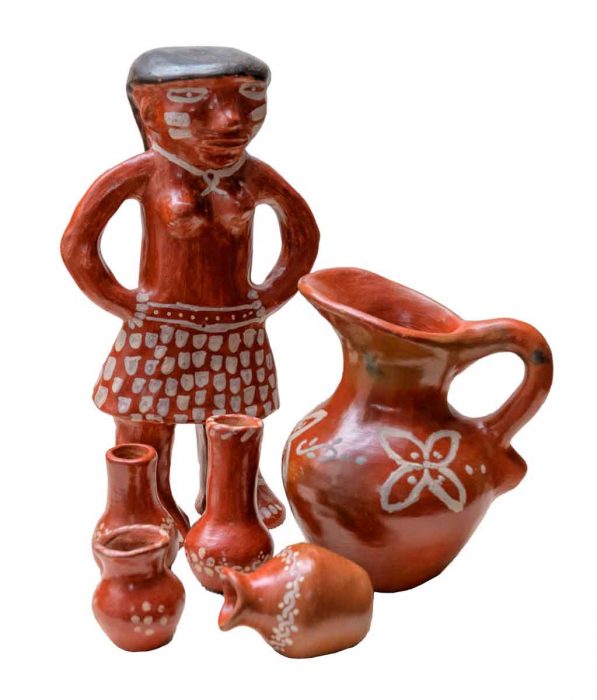
Kadiwéu
Mato Grosso do Sul - Brazil
Descendants of the Guaikurús, a tribe discovered in the seventeenth century by Spanish explorers entering Brazilian lands, the Kadiwéu are the last remaining group of that tribe still living in Mato Grosso do Sul. Called “knight Indians” due to their excellent horse-riding skills (a fact uncommon among Brazilian Indians), they live today in demarcated lands near the city of Porto Murtinho, most of it within the Pantanal region.
Belligerent Indians with a deeply hierarchical society, the Kadiwéu attracted the attention of famous anthropologists such as Darcy Ribeiro and Claude Lévi-Strauss. One of the most studied cultural manifestations of this ethnicity is the geometric patterns of their body paintings created by the women of the tribe with coal dust and genipapo juice. Those symmetrical designs are also used in the characteristic paintings of pots, dishes, vases and gourds of their pottery, giving the pieces an unmistakable visual.

Ofayé Anodi
Brasilândia - Mato Grosso do Sul - Brazil
The Ofayé tribe was first seen by the white man in the seventeenth century, when it was still scattered throughout much of the eastern side of the state of Mato Grosso do Sul, living on the banks of the Paraná, Tietê and Sucuriju rivers. In the last century, with the rapid development of agriculture in the region, the tribe ended up being relocated by the government several times to minimize conflicts with farmers who had already drastically reduced their population, occupying today the village of Anodi, near the city of Brasilândia.
Unlike other tribes living n Mato Grosso and Mato Grosso do Sul, which have straw and ceramics as their main materials, the Ofayé mainly work with stamping, producing delicate handcrafted fabrics with unique designs representing the local fauna and flora, stamped or sewn by hand to produce pillowcases for cushions, tablecloths and other items. Today, the support for this artisanal work is important to rescue the cultural traditions of this ethnic group.

Kambiwá
Serra Negra - Pernambuco - Brazil
Originally from the Serra Negra region, in the backlands of the state of Pernambuco, the Kambiwá Indians are the last remnants of a large group of tribes in that region, expelled from their original territories by the European settlers who, since the beginning of the seventeenth century, went more and more inside the continent in search of land proper for sugar cane planting and cattle raising.
Today, the Kambiwá (whose name means “return to the black sierra”) occupy settlements demarcated by the government near the municipalities of Inajá, Ibimirim and Floresta, in the interior of the state. Like other tribes of the backlands, artisanal works with straw are common in their culture. However, an interesting and much appreciated craft production of this tribe is the wood carving. Typically a male work, the sculptures made of imburama-de-cambão (Amburama cearensis) reproduce images of saints, carrancas and other objects, and other objects, and represent today an important economic income for their villages.
Karajá
Goiás, Mato Grosso, Tocantins and Pará - Brazil
For the Karajás, the river Araguaia and the island of Bananal are references both social and mythological. Its nearly 4,000 inhabitants are divided in villages along its banks, crossing the states of Goiás, Tocantins and Mato Grosso. Socially, the various points of the river demarcate the specific territory for fishing, hunting and ritual practices of each village, known and respected by all others. The river also represents the beginning of its history: the Karajás consider themselves descendants of the mythological people who inhabited a village at the bottom of the river, and who, after finding a passage to the surface, began to live on this side of the world.
The craftsmanship created by the Karajás is very diversified, but it is the clay that still occupies the place of greater prominence within the cultural production of this ethnic group. Recognized today by the Institute of National Historical and Artistic Heritage (Iphan) as Brazilian immaterial patrimony, this production includes from the typical representation of forest animals, common to various other ethnic groups, to the so-called Ritxoko, colored ceramics dolls moulded, painted and burned by the women of the tribe, whose form of representation of the human being plays a prominent role in Brazilian indigenous pottery.

Kayapó
Mato Grosso and Pará - Brazil
With approximately 11,000 inhabitants, the Kayapós are now divided into three large groups, with several other linked subgroups, all living in the Upper Xingu region. Original inhabitants of the region of the River Tocantins (in the state of Goiás), conflicts created after the arrival of explorers in the nineteenth century continuously forced their migration more and more to the West until they arrived at the place where they are currently settled. An interesting fact about their way of life is that they keep their villages in the woods, close to small streams and away from the great rivers, unlike most other tribes, who use its fertile shores for agriculture or as a form of facilitate their locomotion for long distances.
The Kayapós are still reluctant to maintain frequent contact with the white man. However, paradoxically, one of the most widespread craft productions of this ethnic group is based on a material brought by the settlers since the first European expeditions to the new continent: beads. These glass little balls of various colors and sizes are used by Kayapós for the production of earrings, necklaces, bracelets and other ornaments, always using the patterns characteristic of their traditional graphics.

Macuxi
Roraima - Brazil
Inhabitants of the eastern region of the state of Roraima between the headwaters of the Branco and Rupununi rivers, the Macuxi now number more than 20,000 members in Brazil alone, with another 9,000 divided between the Dutch Guyana and the Venezuela. Established in a strategic point of national security, this ethnic group has lived with the invasion of the white man since the XVIII century, when the first Portuguese explored the region. Since then, diverse activities of extractivism (mainly of natural rubber) and livestock farms have taken great areas which belonged to their tribes in the past. Those invasions caused inevitable conflicts that still today threaten the security of the Macuxi.
Today, the craftsmanship of that tribe is very diverse, including leather whips, clay pots, earrings, necklaces and even a series of fun keychains, with pendants made from small sculptures shaped like animals from the Amazon rainforest, such as monkeys, tapirs, parrots and jaguars.

Mehinaku
North of Mato Grosso State - Brazil
Discovered during the expedition of the German explorer Karl von den Steinen in 1884, when the entire Upper Xingu area was finally mapped by the white man, the Mehinakus are established on the left bank of the Curisevo River in the northern area of Mato Grosso state. A tribe with its own language, but without a writing system, they are part of a large chain of interrelationships with other indigenous peoples living in the same region. In this complex system of exchanges, within which marriage with members of other tribes is permitted, the mehinakus have developed over generations similarities between their adornments, haircut, shape of houses and villages, and objects of craftsmanship with those of other peoples of the region.
Within its artisan practice, one of the most important products is the Buriti straw, which is collected by the tribe’s men sometimes in places miles away from the village. After being harvested and dried in the sun during the day, the straw then begins to be worked by the women, who divide their leaves into ribbons, braiding them together with cotton threads to form the colored embroidery patterns of their basketry. The straw is also used to adorn headdresses, square-colored face masks, and wrapped around the ankles to protect against thorns and snake bites during their wanderings in the woods.
This cotton used in the basketry also serves to make white braces adorned with beads used by single men, while the colored ones are reserved for those married. Mehinakus also make wooden animals such as monkeys, armadillos, fish and birds, all finished with characteristic painting patterns. They also make canoes, benches, oars and other objects of their daily lives.

Munduruku
Pará, Mato Grosso and Amazonas - Brazil
The first contact of the Munduruku Indians with the Portuguese settlers was reported in the second half of the eighteenth century. Warrior people who had the habit of mummifying the heads of their dead enemies by believing in their magical properties, this ethnicity was feared by other tribes and dominated culturally all the region near the source of the Tapajós river. After two centuries of clashes with the white man, the nearly 11,000 Munduruku Indians that exist today still live near that river, distributed in 30 villages scattered between the states of Pará, Mato Grosso and southwest of the Amazonas.
An interesting aspect of this ethnic culture is its counting system. Their language only has words for numbers up to five, but nevertheless they have developed their own arithmetic system which allows them to perform approximate mathematical operations with the same acuity as a Westerner who has received school training in that area. The Munduruku handicraft includes ceramics, straw, necklaces and household utensils such as the famous black gourds adorned with traditional graffiti, considered today as one of the symbols of the state of Pará.

Tikuna
Amazonas - Border between Peru and Brazil
With approximately 53,000 inhabitants in the Brazilian Amazon alone, the Tikuna form the largest indigenous group in northern Brazil, mostly settled in villages near the banks of the Solimões River, in a region known as the triple border between Brazil, Peru and Colombia (other 15 thousand individuals live divided between these two countries).
Unfortunately, the great number of its population was not enough to avoid that throughout the twentieth century, rubber tappers and timber companies began to intensively explore their forests. This process if invasion by the white man, bringing violence and unknown diseases, put at risk the social sustainability of the Tikuna and the preservation of its culture. A significant part of the rescue and maintenance of that culture is present in their crafts, which include rattles, animal masks made in wood and dolls. Here, one of the most significant works is that of the famous Tikuna basketry made with dried tucumã straw. Woven primarily by the women of the village, the pieces are dyed with paints and dyes extracted from about fifteen species of different plants.
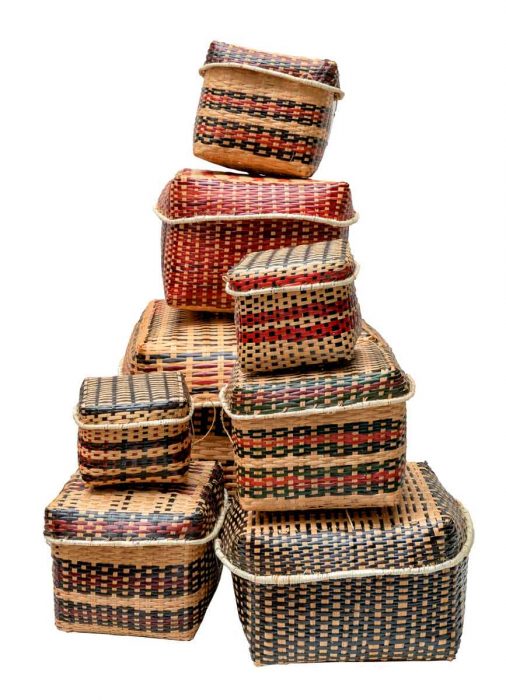
Tukano
Mato Grosso, Pará, Tocantis and Goias - Brazil
The Tukanos live on the banks of the Uaupés River, one of the main tributaries of the Negro River, located in the northwest of the state of Amazonas, near Colombia. This ethnic group includes several others who live in the same region, all with the same language (only the Tariana ethnic group has a different language), forming a broad social system of trade, commerce and personal relationships.
According to the mythology of this tribe, the ancestral forces that created the forest are still present in everything that comprises it, and therefore, each animal, plant and even the objects made from materials provided by the forest carry in them that essence. Within this concept, the ritualistic stools manufactured by the Tukanos are an important artisanal work of this ethnic group. Made from a wood called sorva (Sorbus domestica L.) and adorned with geometric designs, they concentrate two types of power: the force of its raw material and the skills and intentions of who manufactured it.
Tupinambá
Near Ilhéus in Bahia - Brazil
When Portuguese explorers arrived on the Brazilian coast, the Tupinambás numbered more than 100,000 individuals, making them the most populous tribes in the Northeast. Famous for their war rituals, in which they devoured the bodies of captured enemies, their customs were widely reported by German and French explorers throughout the sixteenth century.
Five centuries later, today most of their descendants live in urban centers, with only one remaining group – called tupinambás de Olivença – still living in nature, near Ilhéus, in the southern state of Bahia. Among the crafts that this ethnicity produces, the piaçava has a prominent position. With it, the Tupinambás make baskets, mats, adornments and other objects, all colored with natural dyes extracted from plants and seeds of the region.

Tuyuka
Amazonas - Brazil
Indigenous people belonging to the Tukano family of the Amazon, the Tuyuka call themselves “sons of the Stone Snake”, a legendary being who, descending the Negro River from the north, transformed itself into several other snakes (the tributaries of the river), giving rise to several other peoples. Today, its nearly 1,000 individuals inhabit the northwest of the state of Amazonas along the High and Middle Negro River, tributaries of the Uaupés River and parts of Colombia.
An interesting cultural aspect of the Tuiuka is their school education. With the participation of Catholic missions in the region during the 20th century, many members of this tribe were brought into the traditional school system. With the decline in the number of teachers over the decades, their villages organized themselves to keep school education alive, but now integrated into their own culture. The Utapinopona-Tuyuka School was born from this process, an autonomous indigenous school that uses its own language in its teaching process, thus helping to preserve its traditional knowledge. Among these, it is worth mentioning its secular knowledge in the manufacture of hand fans, nets, baskets and other objects made with buriti fiber or straw, and also in the construction of wooden canoes, an important item for locomotion in the Amazon.

Umutina
Mato Grosso - Brazil
Tribe known by their rivals as aggressive and violent against those who tried to invade their lands, the Umutinas also became famous among Europeans for their resistance against any type of occupation. Initially living on the right bank of the Paraguai River at the time of the arrival of colonizers in the region in the late nineteenth century, the bloody conflicts generated by this invasion influenced their move to further north of the state of Mato Grosso, near the river Bugres, tributary of Paraguai River, where its two villages are currently located.
Called Bearded Indians due to the presence of a sparse beard on men – a social pride among them – most of their population was killed in conflicts with extractivists in the region, or by outbreaks of influenza, measles, tuberculosis and pneumonia. Today, this ethnic group is reduced to a few inhabitants living in its own territory demarcated by the government. Besides fishing and farming, they also survive by selling their crafts, which include bows and arrows adorned with feathers, the same ones used by them to hunt.
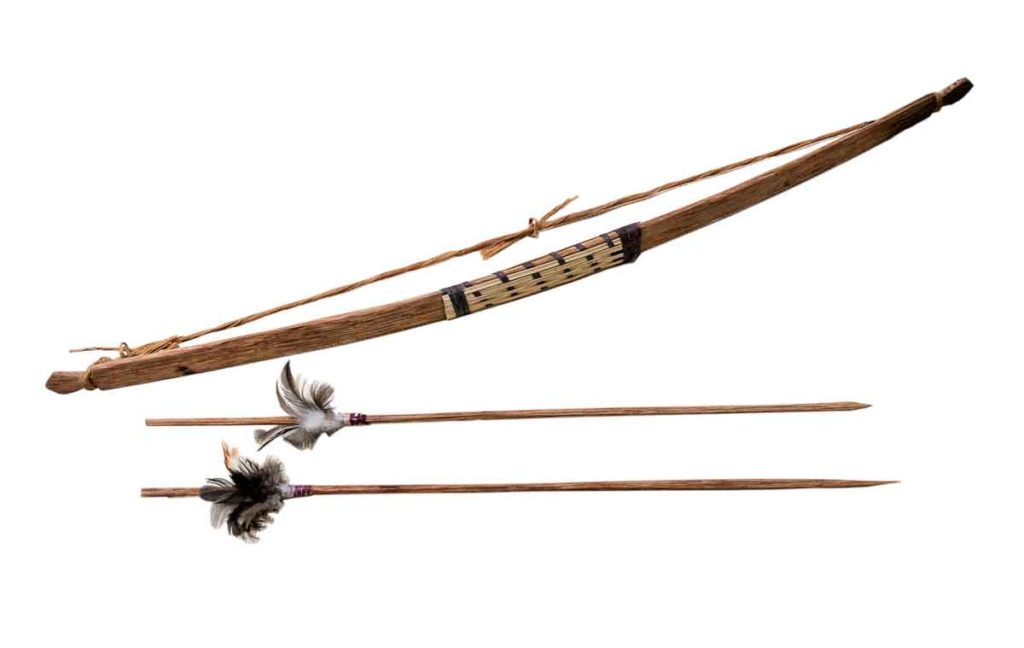
Waurá
North of Mato Grosso - Brazil
Tribe of the Upper Xingu, region in the north of the state of Mato Grosso, the first account of these Indians was made in the late nineteenth century by the German explorer Karl von den Steinen. Today, the Waurás are seated near the Piyulaga lagoon, on the right bank of the Batovi river, located to the west of the large indigenous park delimited by the government in that region. Despite the greater tranquility that this environment provides, the presence of many huge logging and cattle ranching farms close to the park borders still causes many tensions between the Indians and the white man.
The main handicraft production of the Waurás is undoubtedly their pottery, considered by many scholars the most refined among the tribes of the Xingu. Representing local animals as well as more abstract zoomorphic figures, the forms and graphics of their ceramic works give the pieces at the same time a sophisticated flair and a feeling of works deeply rooted in the traditional indigenous art.
Yanomami
North of Amazonas and West of Roraima - Brazil
Divided into four subgroups, each with its own language, the Yanomami are one of the largest indigenous tribes in Brazil, with approximately 15,000 individuals scattered in 255 villages in the states of Roraima and Amazonas – both near the border with Venezuela, where they also have villages. It is believed that the first ancestors of these tribes arrived in the region around the year 1000. However, the first interactions with the white man occurred only in the early twentieth century, a rare occurrence among Brazilian Indians.
The best-known Yanomami handicraft is the straw basketry, created exclusively by the women of the village. Originally made for home use, this basketry uses as the main material the fiber of the titica cypress (Heteropsis Jenmani), extremely durable and resistant. An interesting point of these works is its circular format. Used by them in building their villages, houses, as well as in their haircuts etc., that is a striking element within these tribes’ culture.

Yawalapiti
Mato Grosso - Brazil
Like many other ethnic groups living in the Upper Xingu, the Yawalapiti were discovered during the expedition of the German ethnologist Karl von den Steinen in the late nineteenth century. First seen in 1887, they impressed visitors with their level of poverty, later identified as part of a process of social decline of the group caused by conflicts with other tribes, which later would culminate in the total dissolution of the village around 1930. During that process, part of the group eventually settled in a region called Yakunipi, in the southern part of the Upper Xingu, considered the first village of the present Yawalapiti. Indians from tribes like the Kamaiurá, the Kuikuro, the Kalapalo, the Waurá and the Mehinako also live there.
Living mainly from hunting and fishing, the Yawalapiti’s main craftwork is produced with beads, with which they produce colorful necklaces, bracelets, anklets and other different adornments with intricate patterns. Many pieces have ceremonial and ancestral meaning and are made by female adolescents as a ritual of maturing.
Yawanawá
Alto Rio Negro, Amazonas - Brazil
An ethnic group known for its high sociability, the Yawanawá community gathers Indians from nearby groups, such as the Shanênawa, Yaminawá and Shawãdawa, and is well integrated with the white society (for example, many of them vote in municipal and state elections). Today, most of its nearly 1,000 members live near the head of the Juruá River in the state of Acre, inside the Rio Gregório Indigenous Land. Located next to the municipality of Tarauacá, this i salso the location of the Organization of Extractive Yawanawá Farmers of the River Gregory (OAEYRG), an important center of support for its inhabitants.
The Yawanawá craft activity is quite diverse. Made mostly by the elders of the village, certain productions, such as bows, arrows and spears, are the sole responsibility of men, while others, like pottery and basketwork, are made only by women. From the latter, stand out their beautiful beads necklaces and bracelets, whose traditional graphics are extremely colorful and exquisite.
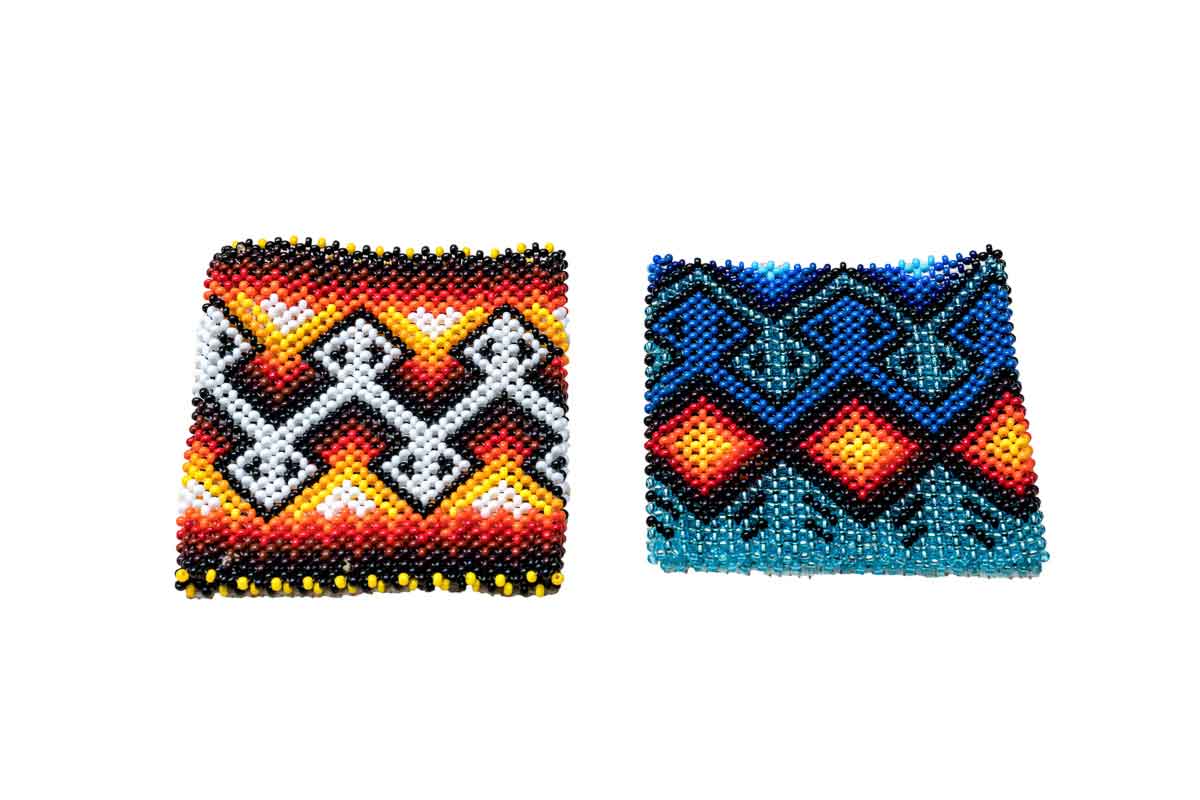
BARÉ
Acre - Brazil
The Baré are an ethnic group from the state of Amazonas which lives near the Xié River, a tributary of the Upper Rio Negro region, where they migrated to escape the violence and exploitation of their work brought by the white settlers over the last two centuries. Today with approximately 4 thousand inhabitants, they are distributed in many villages, whose main ones are Cucuí, Vila Nova and Cué-Cué. The craftsmanship of this ethnic group is closely linked to the work with wood, as is the case of the production of Célio Arago, a resident of the community of Nova Esperança.
Son of carpenter, Célio began to sculpt his art in 2007, at first experimenting with small objects of daily use, as canoe-shaped key holders and picture frames. Inspired by the local fauna, Célio began to choose for his works certain animals unusual to the fairs of the region, as is the case of the colored-spots stingray, a frequent animal in some rivers of the Amazon often captured during the dry season.

HUNI KUIn
Acre border with Peru
The nearly 11,000 Huni Kuin Indians (also known as Kaxinawá) currently live on the border of Peru with the Brazilian state of Acre. Here, their villages populate the right bank of the rivers Tarauacá, Jordan, Breu, Muru, Envira, Humaita and Purus. In the Upper Purus Indigenous Land, they live with their traditional neighbors, the Kulina, for whom this reservation was originally created. In the past, his most enduring contact with the white man began in the late nineteenth century, with the invasion of the region for the extraction of natural rubber. The clashes with the invaders lasted until the 1930s, when the Huni Kuin began on their own initiative to integrate more into the world of colonizers.
Culturally, the Huni Kuin base their craftsmanship and body paintings on the concept of kene kuin – the true drawing. This concept understands painting and graphic patterns as important to emphasize the perfection of people’s bodies and the forms of objects, and are applied as markings of crucial moments in the existence of both. The patterns of their craft with colored beads, so traditional in the North region of the country, are created respecting this belief.
